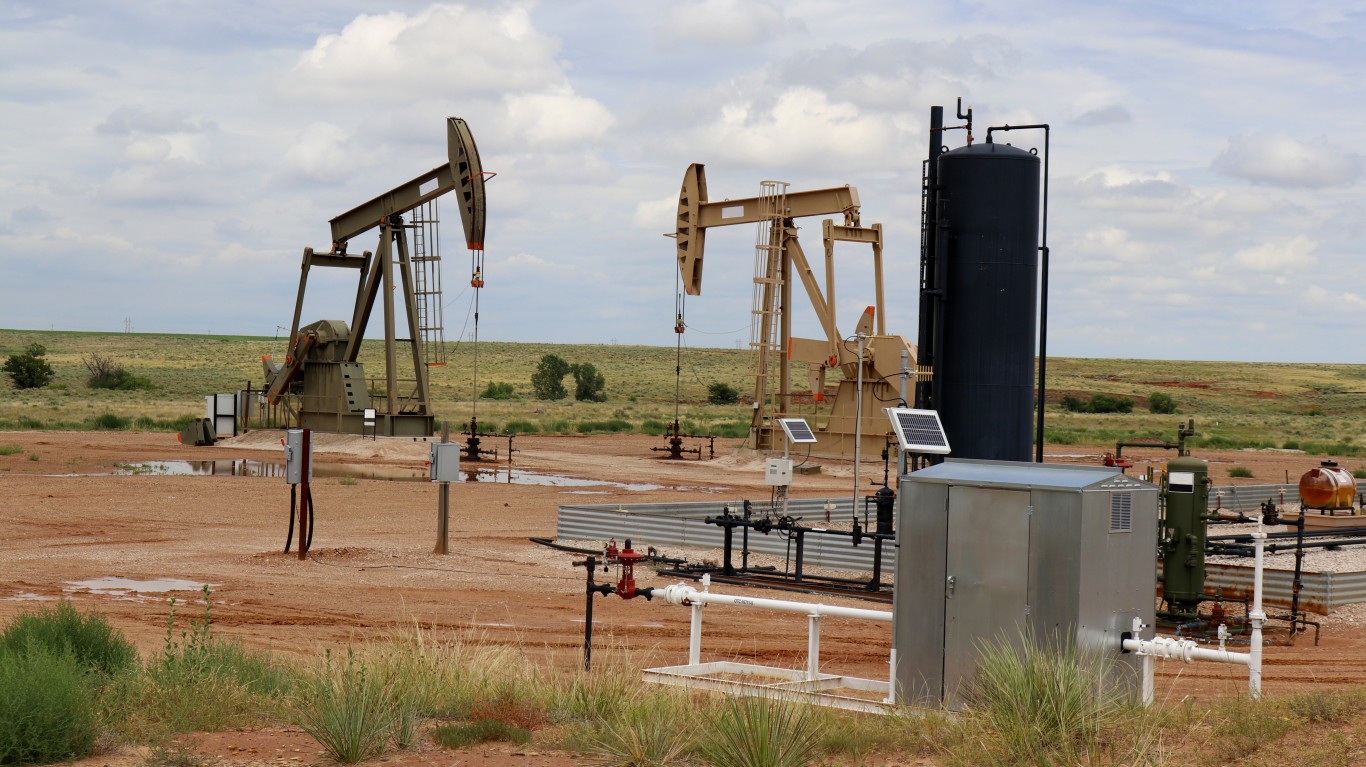Energy
JPMorgan Downgrades Chevron in Ratings, Price Target Shuffle on 7 Oil Patch Stocks

Published:

West Texas Intermediate (WTI) crude oil was trading right around $73 a barrel Wednesday morning, which is up more than 17% since August 20. For the year to date, WTI reached a high of more than $76 on July 2.
[in-text-ad]
Oil and gas exploration and production (E&P) companies track crude price movements but do vary a lot in the percentage changes. Those differences are the result of several factors. In a new look at oil patch stocks, JPMorgan relates the change in oil prices and the price of oil stocks:
While [the first half of 2021] saw a solid move higher in the stocks with the oil price, [the second half] has been more mixed for the stocks despite still strong oil prices. We think that capital allocation discipline and ESG concerns have been factors; however, presuming that discipline prevails, we think that attractive valuation (cheaper than pre-COVID levels), de-leveraging, and return of capital potential all point to further upside.
These comments are specifically aimed at integrated oil companies like Chevron Corp. (NYSE: CVX) and Exxon Mobil Corp. (NYSE: XOM). JPMorgan’s analysts downgraded Chevron from Overweight to Neutral Wednesday morning, “primarily on valuation, but also factoring in higher guided [Energy Transition] spending.” On Tuesday, Chevron announced that it would more than triple spending on reducing its carbon footprint to a total of $10 billion through 2028. JPMorgan’s reasoning appears to be that money spent on lowering carbon emissions cannot be used to pay down debt or boost capital returns to shareholders. The analysts lowered their price target on the stock from $128 to $111, almost 10% below the average of $122.73.
The analysts left its Overweight rating and $76 price target on Exxon, but removed the energy giant from its Analyst Focus List. The average price target on the stock is $66.25. Since the beginning of the year, Exxon’s share price has increased by 43%, more than double Chevron’s 20.6% increase, but still below the 52% jump in the price of crude.
The overall story is a bit different among the straight E&P companies that have no internal refining and marketing divisions. JPMorgan analysts upgraded SM Energy Co. (NYSE: SM) from Neutral to Overweight and left the price target at $27, a dollar below the average. SM’s “robust” free cash flow (2022 free cash flow-to-enterprise value of 18%), its “attractive valuation,” and its holdings in the Austin Chalk play along the Texas Gulf Coast.
Gulfport Energy Corp. (NYSE: GPOR) and Range Resources Corp. (NYSE: RRC), both focused on natural gas plays in the Appalachian region, were upgraded from Underweight to Neutral. Gulfport’s price target was left unchanged at $88 (the same as the average of 27 estimates), while Range Resources’ price target was raised from $15 to $20, about 15% above the average of $17.46. Natural gas prices are up 110% so far in 2021, more than double the increase in crude oil prices.
JPMorgan downgraded Southwestern Energy Co. (NYSE: SWN) from Neutral to Underweight, citing “the magnitude of hedging losses at higher [natural] gas prices (~$2.3 billion between 3Q21 and 4Q22 relative to EV of $6.3 billion) plus the [price/earnings] overhang associated with the Indigo deal will lead to relative underperformance.” The analysts also trimmed their price target on the stock from $7 to $6. The average price target is $6.40.
Matador Resources Co. (NYSE: MTDR) received an upgrade from Neutral to Overweight and a price target increase from $36 to $37 “based on continued operational outperformance, an attractive mix of growth and FCF generation, [and] increasing shareholder returns.”
Crude oil was trading up about 3.3% Wednesday morning, and all these companies are drafting. Chevron was up about 1.6% to $97.71, in a 52-week range of $65.16 to 113.11. The annual dividend yield is 5.57%.
Exxon traded up about 3%, at $56.22 in a 52-week range of $31.11 to $64.93. Exxon’s annual dividend yield is 6.28%.
SM Energy traded up nearly 13% to $22.86, in a 52-week range of $1.34 to $26.87. The company pays a dividend yield of 0.1%.
Gulfport Energy was about 5.6% higher, at $77.13 in a 52-week range of $58.71 to $82.16. Gulfport does not pay a dividend.
Range Resources traded up about 9.8% to $20.19. Its 52-week range is $5.93 to $20.51. The high was posted earlier in the morning. The company does not pay a dividend.
Southwestern Energy traded up 4.3%, at $5.38 in a 52-week range of $2.18 to $5.85. It does not pay a dividend.
Matador Resources was up about 6.3% to $30.67. The 52-week range is $6.29 to $38.05, and Matador pays a dividend yield of 0.34%.
Are you ahead, or behind on retirement? For families with more than $500,000 saved for retirement, finding a financial advisor who puts your interest first can be the difference, and today it’s easier than ever. SmartAsset’s free tool matches you with up to three fiduciary financial advisors who serve your area in minutes. Each advisor has been carefully vetted and must act in your best interests. Start your search now.
If you’ve saved and built a substantial nest egg for you and your family, don’t delay; get started right here and help your retirement dreams become a retirement reality.
Thank you for reading! Have some feedback for us?
Contact the 24/7 Wall St. editorial team.